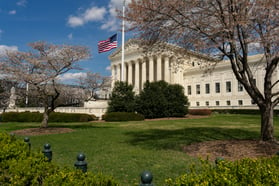 On May 25, the United States Supreme court issued its latest decision interpreting the term “waters of the United States” – increasingly referred to by practitioners as “WOTUS” – subject to regulation under the Clean Water Act (CWA) (Sackett v. EPA). This decision narrows the geographic and hydrologic circumstances under which “wetlands” can be considered WOTUS, reinterpreting previous Supreme Court decisions and effectively overruling the latest efforts by the US Environmental Protection Agency (EPA) and US Army Corps of Engineers (Corps) to define WOTUS subject to their respective CWA jurisdictional authorities. (I’ve written several times about the agencies’ rule making efforts, most recently HERE). The remainder of this note summarizes the Supreme Court’s new definition, and the changes it imposes on the physical extent of CWA jurisdiction.
On May 25, the United States Supreme court issued its latest decision interpreting the term “waters of the United States” – increasingly referred to by practitioners as “WOTUS” – subject to regulation under the Clean Water Act (CWA) (Sackett v. EPA). This decision narrows the geographic and hydrologic circumstances under which “wetlands” can be considered WOTUS, reinterpreting previous Supreme Court decisions and effectively overruling the latest efforts by the US Environmental Protection Agency (EPA) and US Army Corps of Engineers (Corps) to define WOTUS subject to their respective CWA jurisdictional authorities. (I’ve written several times about the agencies’ rule making efforts, most recently HERE). The remainder of this note summarizes the Supreme Court’s new definition, and the changes it imposes on the physical extent of CWA jurisdiction.
What was the Supreme Court’s interpretation of WOTUS wetlands prior to this latest decision?
CWA applies to “navigable waters,” which are defined as “waters of the United States, including the territorial seas.” (42 USC 1362(7)). Before CWA’s initial enactment in 1972, earlier statutes tended to limit federal jurisdiction to waters that were “navigable in fact,” but after CWA dramatically increased federal attention to environmental issues, regulations and policies extended attention to waters (including wetlands) that weren’t navigable, but where their pollution or diversion would affect waters that were – for example, where a non-navigable creek flows into a navigable river, pollutants in the creek will tend to end up in the river. Similarly, some wetlands may relate to navigable waters in a way that their pollution or infill will affect navigable waterways. Agencies and courts have struggled for decades to reach appropriate definitions – or at least regulatory practices – that distinguish appropriate extensions of CWA’s geographic reach from inappropriate extensions.
In 2001’s Solid Waste Agency of Northern Cook County v. U.S. Army Corps of Engineers (SWANCC), the Court ruled that the Corps lacks jurisdiction over “isolated” waters and wetlands that are not “adjacent” to navigable waters—such as “prairie potholes,” mudflats, and freshwater seasonal ponds that don’t drain to navigable waters. Then, in 2006 the justices fractured in Rapanos v. United States; four enunciated one definition and four others another, meaning that the interpretation propounded by the ninth – Justice Kennedy – provided the fifth vote for the (imputed) majority ruling. The three viewpoints were:
- most restrictive – Justice Scalia, joined by 3 other justices, concluded that WOTUS “include only relatively permanent, standing or flowing bodies of water”, not areas subject only to intermittent flows; and to “adjacent” wetlands “with a continuous surface connection to bodies that are [WOTUS] in their own right, so that there is no clear demarcation between ‘waters’ and wetlands.” Since the case under appeal applied the previous expansive analysis, this decision over-ruled it and remanded the case for further review.
- intermediate – Justice Kennedy revived language from SWANCC and other earlier decisions requiring a “significant nexus” between navigable-in-fact waters and the waters or wetlands under consideration. Since the case under appeal applied the previous expansive analysis, this decision also over-ruled it and remanded the case for further review.
- expansive – Justice Stevens, writing for the remaining justices, would have continued to apply the analysis in previous cases and affirmed the lower court.
Since 5 justices voted to overrule and remand the case, that’s what happened, even though Justices Scalia and Kennedy sharply criticized one another’s approaches. Subsequently, agencies and courts generally applied the “significant nexus” approach since it was necessary to reflect a majority of the justices’ views.
What were the facts behind this case?
This case arose when Michael and Chantell Sackett purchased property in 2004 near Priest Lake, Idaho, and began backfilling the lot with dirt to prepare to build a home. Soon thereafter, EPA sent them a compliance order informing them that their backfilling violated the CWA because their property contained wetlands protected by CWA, and demanded that they immediately begin to restore the site pursuant to a Restoration Work Plan provided by the agency. EPA had determined that the property held wetlands adjacent to and demonstrating a significant nexus with WOTUS. As summarized in the new Sackett decision “According to the EPA, the ‘wetlands’ on the Sacketts’ lot are “adjacent to” (in the sense that they are in the same neighborhood as) what it described as an “unnamed tributary” on the other side of a 30-foot road [which] feeds into a non-navigable creek, which, in turn, feeds into Priest Lake, an intrastate body of water…” The Sacketts responded by filing a suit claiming that the wetlands are not WOTUS. The case went to the Supreme Court once before to address procedural issues, and has now been heard to decide the proper test to decide whether wetlands are “WOTUS.”
How does the new decision change existing interpretations?
Between 2006 and 2023, several justices retired and have been replaced (2 of 4 who had voted for the narrowest interpretation, Justice Kennedy from the middle, and 1 of 4 who voted for the broadest interpretation). On May 25, 2023 the Supreme Court unanimously rejected application of CWA requirements to the Sackett property wetlands, while offering more than one definition of what types of wetlands should be subject to CWA as WOTUS. Justice Alito wrote the decision of the Court, which was joined in full by four other justices (Barrett, Gorsuch, Roberts, and Thomas); several other justices wrote concurring opinions providing different analyzes of the CWA provisions.
- majority interpretation – rejects “significant nexus” test as being to ambiguous, especially since EPA policies that punish noncompliance effectively require detailed geographic and legal analyses before any work is possible at many locations, and concludes that the restrictive Rapanos plurality was correct: the CWA’s use of “waters” encompasses “only those relatively permanent, standing or continuously flowing bodies of water ‘forming geographic[al] features’ that are described in ordinary parlance as ‘streams, oceans, rivers, and lakes.’” Furthermore, “CWA extends to only those wetlands that are ‘as a practical matter indistinguishable from waters of the United States.’ [quoting the Rapanos plurality]”; put another way, wetlands must be “adjacent” to WOTUS, with a “continuous surface connection.”
- minority interpretation (Kavenaugh concurring, joined by the 3 least conservative justices) – agree with the removal of the “significant nexus” requirement, but disagree with the requirement for “continuous surface connection” as being too restrictive a reading of the statutory application to “adjacent” wetlands (discussing this as a more stringent “adjoining” requirement).
What now?
The revised definition is intended to reduce the wetlands subject to CWA regulation – national environmental advocates claim the change will remove up to 118 million acres from potential regulation (a total area larger than California). EPA and the Corps will need to revise their regulations to reflect the new standard, and adjust their policies and procedures as well. At the same time, at least some states will be reviewing state requirements, seeking to ensure ongoing regulation of wetlands within their jurisdictions.
Self-Assessment Checklist
Does my organization routinely discharge wastewaters:
- Into a natural water body?
- Into an artificial conveyance (ditch, storm sewer, etc.)?
- Into a sanitary sewer system?
Does my organization operate a facility where rainwater or snowmelt might flow:
- Into a natural water body?
- Into an artificial conveyance (ditch, storm sewer, etc.)?
Is my organization undertaking a construction or other project that disturbs a waterway or wetland, or disturbs soil or rock that might contaminate runoff into a waterway?
Has my organization evaluated the receiving waters or wetlands to determine whether they qualify as “waters of the United States” subject to CWA requirements?
- Under the previous judicial standards and regulatory definitions?
- Under the new standard promulgated in Sackett v. EPA?
Has my organization evaluated requirements under state laws in each state in which activities may affect water bodies or wetlands?
Where can I go for more information?
- Sackett v. EPA (5/25/23)
- EPA webpage ‘Revising the Definition of “Waters of the United States”’
- Rapanos v. US (6/19/06)
About the Author
 Jon Elliott is President of Touchstone Environmental and has been a major contributor to STP’s product range for over 30 years.
Jon Elliott is President of Touchstone Environmental and has been a major contributor to STP’s product range for over 30 years.
Mr. Elliott has a diverse educational background. In addition to his Juris Doctor (University of California, Boalt Hall School of Law, 1981), he holds a Master of Public Policy (Goldman School of Public Policy [GSPP], UC Berkeley, 1980), and a Bachelor of Science in Mechanical Engineering (Princeton University, 1977).
Mr. Elliott is active in professional and community organizations. In addition, he is a past chairman of the Board of Directors of the GSPP Alumni Association, and past member of the Executive Committee of the State Bar of California's Environmental Law Section (including past chair of its Legislative Committee).
You may contact Mr. Elliott directly at: tei@ix.netcom.com
